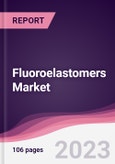Fluoroelastomer is a class of synthetic rubber which is highly resistant to high temperature, heat and chemical changes. Due to several properties of fluoroelastomers such as low gas absorption rate, compression and ozone resistance, fluoroelastomers have been used in various industries such as petrochemical, aerospace, automotive, pharmaceutical and food processing. Fluroelastomers also provide long-term durability even when exposed to corrosive chemicals, so they are adopted in chemical as well as aerospace industries.
The global Fluoroelastomers Market is estimated to grow with a CAGR of 3.18% during 2022-2027. As there is a rise in the demand for fluoroelastomers owing to its excellent chemical and oil resistant properties and stringent emission standards across the global, the fluoroelastomers market is expected to grow further in the upcoming years.
The Fluoroelastomers market is segmented by products, by application and by end user in this report. The market is also segmented by geography, which include North America, South America, Europe, Asia-Pacific, and Rest of the World.
This product will be delivered within 2 business days.
The global Fluoroelastomers Market is estimated to grow with a CAGR of 3.18% during 2022-2027. As there is a rise in the demand for fluoroelastomers owing to its excellent chemical and oil resistant properties and stringent emission standards across the global, the fluoroelastomers market is expected to grow further in the upcoming years.
The Fluoroelastomers market is segmented by products, by application and by end user in this report. The market is also segmented by geography, which include North America, South America, Europe, Asia-Pacific, and Rest of the World.
This product will be delivered within 2 business days.
Table of Contents
1. Fluoroelastomers Market - Market
3. Fluoroelastomers Market - Landscape
4. Fluoroelastomers Market - Startup companies Scenario Premium Premium
Methodology

LOADING...








